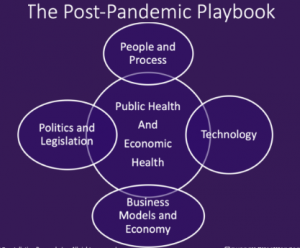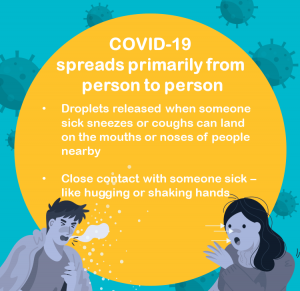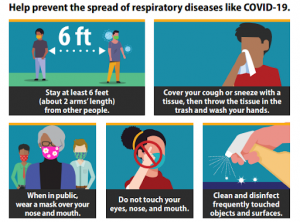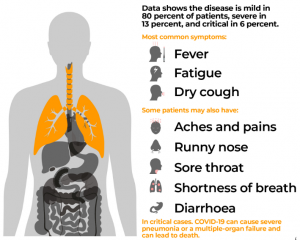
The Role of a Pandemic Playbook in Your Company’s Risk Assessment Strategy
Are you anxious and stressed about reopening your business as the pandemic rages on?
Is your business struggling to recover from the effects of the COVID-19 pandemic?
Then you need to invest in a pandemic playbook!
Disease outbreaks are part of life, and we are always vulnerable. As much as we never know when the next pandemic will occur, we can always expect the scourge to disrupt our way of life.
Outbreaks always impact both human life and the global economy, and we are sure your business has been significantly affected by the COVID-19 pandemic.
In almost a year, the world has been on fire, with businesses and lives disrupted as a result. Few people saw it coming, but what they didn’t anticipate is the scale of disruption to normal life.
We can say that there has been some quiet warnings since the outbreak of Ebola, the Zika virus, and cholera among others. All the previous outbreaks have consumed billions of dollars and the current one will be no different.
Sadly, despite the years of preparations to prevent a pandemic of this scale, we are here again with no viable solution in sight.
We should be learning from the scourge and band together by heeding the numerous lessons drawn from history and previous outbreaks.
To get ahead, we need to examine the strategies that were successful in the past, as well as those implemented by different countries, as advised by health advisors and doctors.
This is where the importance of a pandemic playbook is essential. Every business must build a post pandemic playbook to have a chance of surviving the scourge.

Having a pandemic playbook that helps fight COVID-19 propels us ahead of the curve. However, this requires assembling vital components of the outbreak, including statistics to create a successful strategy.
To make this an easy read, here’s what we will cover:
[A] Components of a pandemic playbook
#1 Recognizing the existence of a problem
#2 Understanding the nature of the disease
#3 Minimizing the pandemic
#4 Communicating possible risks
#5 Preparing a response
[B] Pandemic recovery plan
#1 Implement mandatory screening, testing, and verification
#2 Implement a partial return to work plan
#3 Update travel policies and manage workstations
#4 Explore a new mode of engaging customers
#5 Pursue perfect execution
[A] Components Of a Pandemic Playbook
#1 Recognizing the existence of a problem
Did you know that the world is on fire because we assumed that the clusters will not spread beyond China?
Outbreaks never announce themselves. Initially, no one thought it would be a pandemic of such colossal proportions. Outbreaks always begin with a few clusters from a singlee location and a statistical quirk. Slowly, things get off track.
The global economy with an advanced transport system only makes it easier for the outbreak to spread, as was the case with every other outbreak before COVID-19.
For example, in 2019, the aviation industry was booming, and flights were coming from all corners of the globe. The interconnectedness of world affairs and modern transport efficiency was finally used by the virus to spread like wildfire on a global scale.
Within days, every flight was a contagion vessel. The statistical quirk kicks in because cases are now arriving in major cities globally, ensuring that the outbreak is no longer a local problem. This is exactly what happened after the outbreak started in China.
The recognition process must be smooth and efficient. Moreover, medical establishments must connect and recognize any unusual patterns, which must be reported to senior management.
Then, those in management positions must act quickly to alert international authorities. The virus’s pathology should be examined thoroughly, as even a little outbreak can turn into a global pandemic.
It all starts by infecting thousands of people, and before you know it, the whole country or world is at risk of infection.
China acknowledged the problem late (towards the end of 2019). If the outbreak was recognized early and the WHO alerted in time, monitoring and preparations would have been better.
#2 Understanding the nature of the outbreak
“The outbreak was immaterial.” – WHO
This statement by the World Health Organization blindsided everybody. Clearly, there was no thorough pathology investigation after recognizing the mysterious virus.
It would have helped to know its mode of transmission, which could have assisted in more effective management.

Managing a contagion requires understanding it and knowing how it spreads, as well as how it uses humans as carriers. Remember, a new outbreak is a challenge, and you are literally navigating uncharted waters.
For something to be called a pandemic, it means the disease is spreading worldwide.
At a glance, it may not be possible to comprehend how it spreads, but we gain a better understanding of the disease through research.
Plus, it’s hard to tell who are carriers and whether they are contagious or how lethal the disease is until you do research.
For example, consider a reproductive number, say R-zero. If the number is three, then every infected person can infect three other people. At face value, it doesn’t seem like much.
However, if you dig deeper, you realize that every time a person is infected, they infect the next three. Eventually, you have a substantial number of infections from a single infected person.
Now increase your R-zero to say six, and you have the entire population of countries getting infected at an alarming rate. The R-zero for measles was 12-18. Now you understand how devastating this can be?
Communicability is important, and people should never assume anything. Remember, Ebola had a communicability range of 90 percent and MERS 35 percent, which is the worst-case scenario.
However, COVID-19 has done the unthinkable and proved the theory wrong.
Scientists continue to study the numbers to learn more, even as the disease continues to spread.
Health officials study the numbers and catalog cases using machine resources and the best minds to sequence genomes and make analytical predictions.
#3 Minimizing the pandemic
“It can be difficult for leaders to decide what to prioritize, even in the short term.” – Sam Reese
Now that you understand the disease, it’s best not to underestimate it. Those unexpected little clusters can quickly become another outbreak. The crucial part is to devise a strategy that saves lives and prevents the situation from getting worse.
The type of response that is in place determines the cost to human life and the economy, as well as whether there will be a temporary loss of civil liberties.
It may be necessary to contain people to prevent them from contact-spreading the disease. Containment measures can include closing down your facilities temporarily or using staggered entry to manage capacity.
Moreover, you need to quarantine people showing symptoms you don’t understand. Such actions are necessary when the disease is still in the contagious phase during the incubation period, as is the case with COVID-19.

Some diseases don’t show signs for days, like COVID-19 (14 days incubation). At this stage, carriers continue to interact with friends, coworkers, and other people.
This makes it challenging to perform contact-tracing as it involves extensive data harvesting and more testing to understand the disease and the mechanisms by which it spreads. Whatever decision you make, you will have to explain it to the public.
#4 Communicating possible risks
The moment the pandemic news hit the waves, it will be the only thing everyone is talking about.
Also, people react differently, with some wanting to help, while others rally against whatever actions you decide to take to contain the outbreak. There will be fake news and conspiracy theories to contend every step of the way.

To handle things soberly you’ll need good advice. Your communication must be clear, and you need to explain concepts like social-distancing and hand-washing.
It’s not wise to concentrate on a singular message that only the sick and old are vulnerable. Everyone is susceptible unless they are immune.
Try to encourage the appropriate behavior and give incentives. The goal is to make people understand the risks because the disease is lethal, and you want to contain its spread to the rest of the population.
Be firm in your communication, and avoid making it sound like suggestions, since this will be confusing.
Guard against encouraging complacency and further sparking panic. Try and work with local businesses or the private sector. For instance, supermarkets can self-police to stop stockpiling while watching market fluctuations. Help these people to coordinate effectively.
Communicate effectively to prevent a similar catastrophe to the COVID-19 crisis. Provide insights and help manage the situation by using a hands-on approach.
#5 Preparing a response
Look! Since you will get advice from many sources, you need to quickly prioritize. Some people advising you already have vested interests, and some mean well but may lack experience.
Create a reliable strategy that works. You can borrow from people and organizations like WHO, which have been preparing, thinking, and facing similar challenges at a local level for years.
Coordinate widely and order sufficient necessary medical supplies, like PPEs and ICU equipment. Also, ensure that hospitals have vital pharmaceutical supplies, like muscle relaxants and painkillers.
Rally for a pass of necessary emergency legislation to guard against people terming your actions as overreach, but view those actions as necessary in the short-term.
You need more first responders, like healthcare workers, police, volunteers, and the military on standby. Instill pride in service and encourage teamwork.
Clapping and singing on balconies help people to appreciate your efforts instead of being overly strict on them and their movements, causing them to lash out.
[B] Pandemic Recovery Plan
#1 Implement mandatory screening, testing, and verification
Without customers and great employees, there’s no business to plan for.
As a proactive measure, screening, testing, and verification are vital. The process cuts across all visitors and employees.
Encourage your administrators to implement risk assessment screening, including inquiring about travel patterns and conducting temperature checks.
Provide your employees with PPEs and request visitors to wear PPEs when entering public spaces and offices. Health experts agree that PPEs limit the spread of COVID-19.
Therefore, workplaces should have them available and insist on people wearing them correctly to prevent infection.
#2 Implement a partial return to work plan
The best leaders ensure that their teams regularly connect, while exercising flexibility.
Ask your workforce to schedule alternate shifts to help reduce overcrowding in offices.
Encourage them to keep their schedules flexible and work night shifts. All at-risk and non-essential staff should remain at home or work from home.
Implementing a staggered working environment is ideal and encourages employees to work from home. Therefore, your staff don’t have to come to work every day.
Employees should only attend team meetings in a spacious room where social distancing is appropriate. This approach reduces the spread of infection.
#3 Update travel policies and manage workstations
Limit travel to COVID-19 hotspots and even impose mandatory quarantine for all those returning from overseas travel and hotspot areas. Also, ensure that your staff observe social distancing rules.
Increase the distance between workstations to six feet, at least. Educate workers on what to do should someone show symptoms, to avoid spreading the disease.
#4 Explore new modes of engaging customers
One thing COVID-19 has taught us is that we need to change our behavior. Recently, the CDC encouraged consumers and businesses to consider using contactless payment solutions.

Sorry, the comment form is closed at this time.